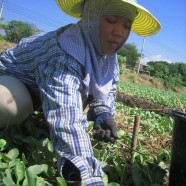
by Rosalie Ellasus
Do judges know better than mothers what their children should eat?
In the Philippines, apparently they do. Or at least they think they do.
Last month, my country’s Court of Appeals stopped field tests on genetically modified eggplants—crops that I would happily feed my own children and grandchildren.
We’ve been eating GM crops for years. I grow them on my farm in San Jacinto during the dry season. They’re such excellent crops that I plant them on the 12 hectares that I own and also rent an additional 3.5 hectares.
I’ve also grown eggplants. They’re the leading vegetable crop in the Philippines, where we call them talong. They come in many shapes and colors, from elongated or rounded to purple, violet, or green. Some even have white stripes.
Mothers like me can cook talong a hundred different ways, but one of everybody’s favorite dishes is called pinakbet. Talong is a main ingredient, along with other vegetables as well as fish or shrimp, all stirred together in a hot and delicious mix.
If you were to ask Filipinos to pick their favorite Filipino plate, pinakbet probably would win the contest.
I’m very concerned that the judges have ruled against a technology that would make it easier for farmers to grow talong and mothers to feed it to their children.
If their decision had been based in sound scientific reasoning, then it would make sense and be accepted. Farmers don’t want to hurt the environment and mothers don’t want to feed harmful food to their children.
But the ruling had nothing to do with science. The judges simply reacted to the lies of activist groups such as Greenpeace, whose well-fed leaders never have to wonder about their next meal.
Biotechnology is widely accepted around the world, where farmers have harvested more than 3.5 billion acres of it over the last 20 years.
A few of those acres have been mine. I started growing GM crops shortly after the death of my husband. They helped me get my life back together and gave me the financial means to send my children to school.
They also put food on the table. I mean this both figuratively and literally because in my home we eat what we grow—and our GM corn uses exactly the same pest-fighting technology that the Court of Appeals just rejected for talong.
This is ridiculous. How can a trait be acceptable in one crop but not in another?
My personal experience demonstrates what scientists all over the world have said: GM crops are a safe and proven option. That’s what the World Health Organization, the American Medical Association, and many other groups have proclaimed, along with the National Academy of Science of Technology here in the Philippines.
One of the latest voices to endorse GM food is Michael Purugganan, a Filipino who is the dean of science at New York University, a preeminent university in the United States.
“When it comes to GM technology, [critics] ignore the overwhelming scientific consensus on the safety of GMO crops,” he wrote in GMA News Online, responding to last month’s ruling. “Meanwhile, here in the U.S., I will eat GMO tortilla chips and eat GMO tofu. I hope to one day taste GMO pinakbet. And I do so fully aware that I have nothing to worry about.”
I’ll take it a step further. Biotech crops aren’t merely just okay to eat. They’re actually better than non-biotech crops. They allow us to grow more food on less land, making them tools of conservation and sustainable agriculture. They also improve the health of farmers because they don’t require additional pesticide applications, which can be hazardous to the people who apply them directly to crops.
With its unfortunate decision, the Court of Appeals has hurt the international reputation of the Philippines, which now may be viewed as a foe of progress and technology. More importantly, it has hurt the prospects of ordinary Filipinos, from farmers who struggle to make a living to mothers who simply want safe and affordable ways to feed their children.
Rosalie Ellasus is a first-generation farmer, growing corn and rice in San Jacinto, Philippines. Rosalie allows her farm to be used as a demonstration plot for smallholder farmers to visit and learn from. She is a member of the Truth About Trade & Technology Global Farmer Network



Recent Comments